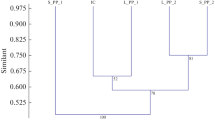Summary
The distribution of nematophagous fungi in soil collected from a deciduous woodland is compared to various biotic and abiotic soil factors. The microfungi are isolated at all depths down to a maximum of 35 cm. Predators forming constricting rings, adhesive branches and adhesive knobs are restricted to the upper litter and humus layers. The net forming predators and endoparasites are isolated at all depths, although they are significantly more abundant in the lower mineral rich soils. A much greater species diversity of nematophagous fungi is recorded in the upper organic zones.
Preliminary soil analysis indicates thatCephalosporium balanoides is independent of all soil variables, while predators able to form traps spontaneously are restricted to the organic soils which are rich in nematodes. Non-spontaneous trap forming predators, which are excellent saprophytes, are isolated from the deeper soils which are low in nutrients. The ecological significance of these results is discussed.
Similar content being viewed by others
References
Allen S E 1974 Chemical Analysis of Ecological Materials. Blackwell, Oxford, 565 p.
American Public Health Association 1981 Standard Methods for the Examination of Water and Wastewaters. American Public Health Association, Washington, 1133 p.
Burges A and Raw F 1967 Soil Biology. Academic Press, London, 532 p.
Cooke R C 1963 Ecological characteristics of nematode-trapping Hyphomycetes: I. Preliminary studies. Ann. Appl. Biol. 52, 431–437.
Cooke R C 1963 Succession of nematophagous fungi during the decomposition of organic matter in soil. Nature London 197, 205.
Dean W E 1974 Determination of carbonate and organic matter in calcareous sediments and sedimentary rocks by loss on ignition: comparison with other methods. J. Sed. Petr. 44, 242–248.
Dickinson C H and Kent J W 1972 Critical analysis of fungi in two sand dune soils. Trans. Brit. Mycol. Soc. 58, 269–280.
Dowding P and Widden P 1974 Some relationships between fungi and their environment in tundra regions.In Soil Organisms and Decomposition in Tundra. Ed. A J Holding et al. Tundra Biome Steering Committee, Stockholm, 123–150.
Duddington C L 1955 Notes on the techique of handling predaceous fungi. Trans. Brit. Mycol. Soc. 38, 97–103.
Eisenreich S J, Bannerman R T and Armstrong D E 1975 A simplified phosphorous analysis technique. Env. Lett. 9, 43–53.
Gray N F 1983 Ecology of nematophagous fungi: distribution and habitat. Ann. Appl. Biol. 102, 501–509.
Gray N F and Smith R I L 1984 The distribution of nematophagous fungi in the maritime Antarctic. Mycopath. 85, 81–92.
Gray N F 1984 Ecology of nematophagous fungi: comparison of the soil sprinkling method with the Baermann funnel technique in the isolation of endoparasites. Soil Biol. Biochem. 16, 81–83.
Gray N F 1984 Ecology of nematophagous fungi: methods of collection, isolation and maintenance of predatory and endoparasitic fungi. Mycopath. 86, 143–153.
Gray N F 1985 Ecology of nematophagous fungi: effect of soil moisture, organic matter, pH and nematode density on distribution. Soil Biol. Biochem. (In Press).
Gray N F 1985 Ecology of nematophagous fungi: effect of the soil nutrients N, P and K, and seven major metals on distribution. Soil Biol. Biochem. (In Press).
Gray N F 1985 Nematophagous fungi from the maritime Antarctic: factors affecting distribution. Mycopath. (In Press).
Holm E and Jensen V 1980 Microfungi of a Danish beech forest. Holarctic Ecol. 3, 19–25.
Jansson H B and Nordbring-Hertz B 1979 Attraction of nematodes to living mycelium of nematophagous fungi. J. Gen. Microbiol. 112, 89–93.
Kent J W 1972 Application of statistical techniques to the analysis of fungal populations. Trans. Brit. Mycol. Soc. 58, 253–268.
Peterson E A and Katznelson H 1965 Studies on the relationship between nematode trapping fungi in the vicinity of plant roots. Can. J. Microbiol. 11, 491–495.
Scheiner D 1976 Determination of ammonia and Kjeldahl nitrogen by the indophenol method. Wat. Res. 10, 31–36.
Siegel S 1956 Non-parametric Statistics for the Behavioral Sciences. McGraw-Hill, Tokyo, 312 p.
Author information
Authors and Affiliations
Rights and permissions
About this article
Cite this article
Gray, N.F., Bailey, F. Ecology of nematophagous fungi: vertical distribution in a deciduous woodland. Plant Soil 86, 217–223 (1985). https://doi.org/10.1007/BF02182896
Received:
Revised:
Issue Date:
DOI: https://doi.org/10.1007/BF02182896



